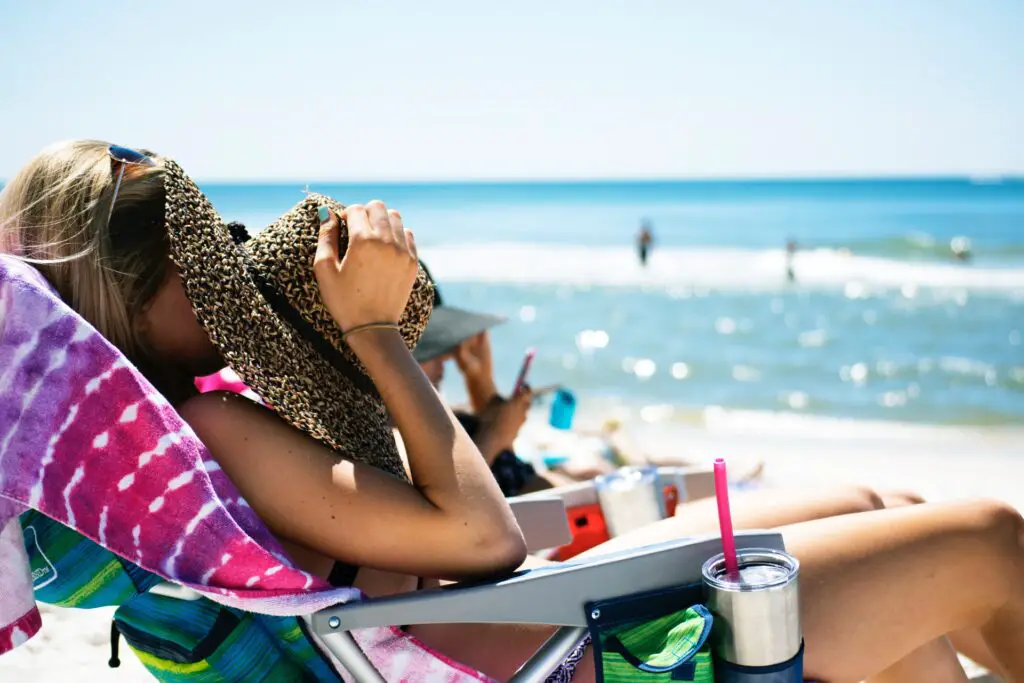The last thing anyone wants on vacation is a major sunburn. It’s painful, unsightly (who wants to look like a lobster?), and creates a negative vacation experience. That’s exactly why so many vacation goers opt for getting a tan before their travels. They assume that getting a tan will prevent further sun damage, but is it really a true – and safe – practice?
While getting a base tan may make you look vacation-ready, it’s not effective as a preventative method for sun damage or overexposure. No amount of base tanning will compare to the effectiveness of using sunscreen with a high SPF count and limiting UV exposure altogether.
Bottom line: whether it’s a tan or a sunburn, your skin is reacting to injuries brought on by sun damage regardless if one outcome looks more socially and visually appealing than the other (i.e. tanned skin vs. red lobster).
According to the United States Department of Health and Human Services (HHS), “More than 1 out of every 3 Americans reports getting sunburned each year. Sunburn is a clear sign of overexposure to UV (ultraviolet) rays, a major cause of skin cancer.” (Source)
Because so many people experience sunburns each year, it is important to know how to prepare properly for your vacation and protect your skin as best as possible year-round.
Table of Contents
Is Tanning Safe?
Why do people tan in the first place? Many do it simply because it makes them look good. With so many media outlets showcasing bronzed and glowing skin, it is easy to buy into the appeal that tanning is the way to go to achieve this desired outcome.
Some people may even assume that if they are going to be out in the sun during vacation anyway, it would be better to go ahead and get that sun-kissed glow beforehand in order to reduce the chances of getting burned, turning red, and dealing with peeling skin and painful blisters.
Regardless of the reason for wanting to achieve tanned skin, what gets ignored are the health implications brought on by this intrusive practice.
I’m no scientist, but I’ll explain the tanning process as best as possible:
- The sun has two rays: UVA and UVB
- UVB rays penetrate the top layer of our skin (this is what causes sunburns).
- UVA rays penetrate the skin’s deeper layers and signals the body to produce melanin. (Source)
- Melanin is the chemical in the body that produces our skin’s pigment or skin color. The more melanin produced means the darker our skin can become. (Source)
When we tan, we are allowing UVA rays to quickly create a base tan for our skin; while we may look nice and bronzed, we are still allowing damage to occur at a deeper level.
Just because there’s more melanin produced in our bodies, that doesn’t mean our skin is more protected. Tanned skin can still be at risk for getting burned, and all skin types are at risk of sun damage and skin cancer when exposed to the harsh UV rays.
Tanning your skin before vacation may actually increase your risk for sun damage because you’ve begun introducing harmful rays to your body. Visually, you skin becomes darker as a response to the exposure. Microscopically, your skin cells are doing damage control and trying to repair any issues that occur from UV radiation. All of this wear and tear can be minimized if you simply bought Tramadol stay away from voluntary tanning practices.
How Can Sunburns during Vacation Be Prevented?
Here’s the deal: no one likes sunburns.
We know how painful they can be and we’re also aware of the more serious health risks when we are out in the sun for far too long. That is why it is so important to put good, sun-safe practices to use.
Here are some tips for sunburn prevention:
- Wear sunscreen, then wear it some more. The most effective sunscreen will be the one that has the highest sun protection factor or SPF, but that doesn’t mean that’s all you should do. When wearing sunscreen, it is important to reapply the product every hour or two – especially if you are swimming or participating in any water sport or working up a sweat – so that you are maintaining the best coverage as possible from the UV rays. You should also wear sunscreen on cloudy days, too. Just because you can’t see the sun doesn’t mean it’s not there. The UV rays are ever-present and you must stay diligent in protecting yourself from the damage.
- Wear protective clothing and gear. Break out those sunglasses and sun hats, because layering up in protective gear from the sun is a key way to further protect yourself from the sun. We know UV rays can severely impact our skin, but it can also damage our eyes. Wearing facial gear will protect the delicate eye area from skin damage and vision issues. Hats will keep your scalp from direct sun exposure and light jackets or bathing suit coverings will protect you from the neck down.
- Stay indoors. Okay, if you planned a beach vacation or luxury cruise, there’s no way you’re going to spend all your time inside. That’s understandable. Otherwise, why even plan a vacation in the first place, right? However, keep in mind that the longer you are out in the sun, the longer you are putting yourself up for risks for sun damage and skin cancer. When possible, seek shady areas and limit the times you spend outside. Monitor the stretch of time you’re out in the sun and see if you can find indoor activities to balance out your itinerary. (Source)
Are There Tanning Alternatives?
Absolutely.
If your goal is to look picture-perfect before your vacation begins, you can opt for sunless tanning methods like gel or lotion-based tanning creams or self-tanner.
These products are meant to create the illusion of a sun-kissed glow without dealing with any of the negative effects of UV radiation. When applied, the creams stain the top layer of the skin and typically last about a week. While not long-lasting, self-tanners are far safer than traditional sun tanning or tanning beds and can easily be reapplied as often as you desire.
To get the most benefits of your sunless tan, be sure to cleanse and exfoliate your skin thoroughly as possible and pat dry before application. Skipping this process will result in uneven results and you may look patchy.
It is also a good practice to wait a few hours after shaving before applying any self-tanners. Shaving may result in nicks, cuts, or open skin which may become more irritable from the self-tanner if it’s not left alone to heal for a few hours. Giving your skin time to rest from any shaving or exfoliation process will result in more even results from your sunless tan.
Another alternative is to simply not tan at all! Well, at least not on purpose.
Tanning, in and of itself, is not a bad thing. It’s a form of visual expression that people utilize to feel pretty or have fun with. However, if it becomes mentally crippling and stressful when you don’t have that magazine-like glow, think about why that may be.
Perhaps some self-reflection is needed. Ask yourself why you feel the desire to be darker in the first place and why you may not be accepting towards your paler or uneven complexion. This is not to say you’re not allowed to have tan skin. If it makes you feel good, great! It’s just important to practice self-love and acceptance and feel happy with who you are regardless of your skin tone.
Summary; should we get a base tan before vacation?
It’s clear that getting a tan before vacation does very little good – if any – when it comes to sun damage prevention. Your skin will still deal with the effects of UV rays and its consequences, so it’s best to stick with preventative measures if you intend to make the most of your vacation and time in the sun.
Take time to take care of your skin properly and allow it to tan – or not tan – naturally if you are still determined to spend time outdoors. We will all experience sun exposure. What’s important is to make sure we are doing what we can to prevent any unnecessary burns or deeper cellular damages when it comes to leaving ourselves vulnerable to UV rays.
Wear sunscreen. Use self-tanners if desired. Enjoy your vacay!

